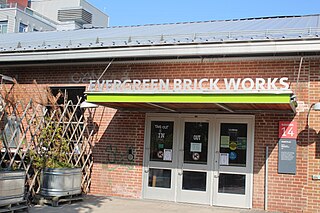
The Don Valley Brick Works is a former quarry and industrial site located in the Don River Valley in Toronto, Ontario, Canada. The Don Valley Brick Works operated for nearly 100 years and provided bricks used to construct many well-known Toronto landmarks, such as Casa Loma, Osgoode Hall, Massey Hall, and the Ontario Legislature. Since the closure of the original factory, the quarry has been converted into a city park which includes a series of naturalized ponds, while the buildings have been restored and opened as an environmentally focused community and cultural centre by Evergreen, a national charity dedicated to restoring nature in urban environments.

Lithgow is a town in the Central Tablelands of New South Wales, Australia and is the administrative centre of the City of Lithgow local government area. It is located in a mountain valley named Lithgow's Valley by John Oxley in honour of William Lithgow.

Sydney Park is a 41.6-hectare (103-acre) recreational area in the inner-city area of Sydney, New South Wales, Australia. The parkland is located in the suburb of Alexandria, sitting along the borders with Newtown and Erskineville.

Lithgow railway station is a heritage-listed former station master's residence and railway station located on the Main Western line at Railway Parade, Lithgow, City of Lithgow, New South Wales, Australia. It was designed and built by New South Wales Government Railways and built from 1924 to 1925. It is also known as Lithgow Railway Station Group and Residence and Eskbank East. The property was added to the New South Wales State Heritage Register on 30 August 2013. The station has frequent NSW TrainLink services running to and from Sydney Central.

The City of Lithgow is a local government area in the Central West region of New South Wales, Australia. The area is located adjacent to the Great Western Highway and the Main Western railway line.

The Hoffmann kiln is a series of batch process kilns. Hoffmann kilns are the most common kiln used in production of bricks and some other ceramic products. Patented by German Friedrich Hoffmann for brickmaking in 1858, it was later used for lime-burning, and was known as the Hoffmann continuous kiln.
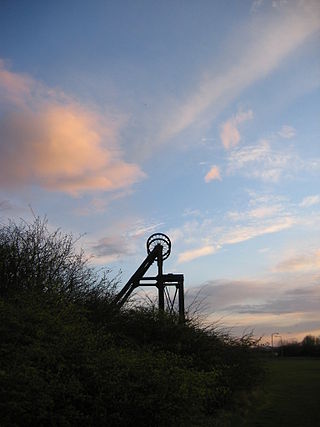
Prestongrange Museum is an industrial heritage museum at Prestongrange between Musselburgh and Prestonpans on the B1348 on the East Lothian coast, Scotland. Founded as the original site of the National Mining Museum, its operation reverted to East Lothian Council Museum Service in 1992.
Brickworks is Australia's largest brick manufacturer, consisting of four divisions – Building Products Australia, Building Products North America, Industrial Property, and Investments.
J. Hallett and Son, founded in 1904, was for most of the 20th century South Australia's most important brickmaking firm. Founded by Job H. Hallett in 1889, his son Thomas Hallett became a partner in 1904. There were several sites across Adelaide's western suburbs, with Halletts retaining their identity until the 1960s, when the company was absorbed by the Nubrik Hallett group.

The Brunswick Brick Tile & Pottery Company was established in 1870 on a 12-acre paddock on Albert Street Brunswick, as one of the first modern mechanical brickworks in Australia. It was also known as the Hoffman Patent Brick & Tile Company, Hoffman Brickworks, or just ' Hoffman's' for most of its 100 plus years of operation.
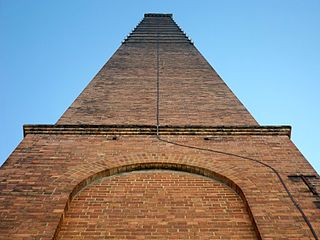
Newmarket Brickworks Chimney is a heritage-listed brickworks at 117 Mina Parade, Alderley, City of Brisbane, Queensland, Australia. It was built in 1912. It is also known as Hoffman Stack. It was added to the Queensland Heritage Register on 24 March 2000.
Thomas Brown was a Scottish-born Australian politician.
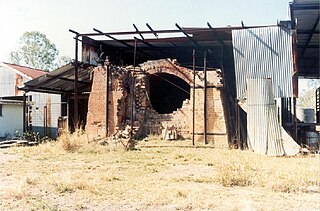
Pindi Pindi Brickworks is a heritage-listed former brickworks off the Bruce Highway, Pindi Pindi, Mackay Region, Queensland, Australia. It was built in 1933. It is also known as Evans Firebricks Ltd and Pindi Pindi Firebricks Company. It was added to the Queensland Heritage Register on 27 October 2000.

The Lithgow Blast Furnace is a heritage-listed former blast furnace and now park and visitor attraction at Inch Street, Lithgow, City of Lithgow, New South Wales, Australia. It was built from 1906 to 1907 by William Sandford Limited. It is also known as Eskbank Ironworks Blast Furnace site; Industrial Archaeological Site. The property is owned by Lithgow City Council. It was added to the New South Wales State Heritage Register on 2 April 1999.

The Lithgow Coal Stage Signal Box is a heritage-listed former railway bridge and now railway signal box at Gas Works Lane, Lithgow, City of Lithgow, New South Wales, Australia. It was designed by New South Wales Government Railways and built from 1885 to 1925 by NSW Government Railways. The property is owned by Transport Asset Holding Entity, an agency of the Government of New South Wales. It was added to the New South Wales State Heritage Register on 30 August 2013.
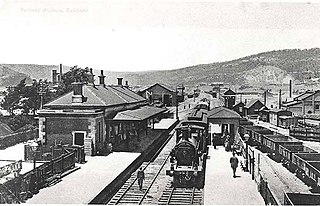
The Eskbank railway station is a heritage-listed former locomotive depot and railway station and now community group venue adjacent to the Main Western Line at Lithgow, City of Lithgow, New South Wales, Australia. It was designed by the New South Wales Government Railways and the station building was built by Goodsell & Wright, as a contractor. It is also known as Eskbank Railway Station group and Lithgow Goods Station/ Lithgow Site S1. The property was added to the New South Wales State Heritage Register on 2 April 1999.
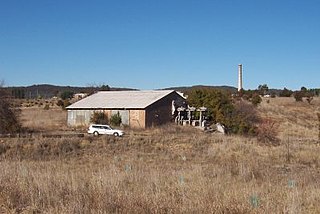
Raffan's Mill and Brick Bottle Kilns is a heritage-listed lime kiln at Carlton Road, Portland, New South Wales, Australia. It was built from 1884 to 1895 by George Raffan and Alexander Currie. It is also known as Raffan's Mill and Brick Bottle Kilns Precinct, Portland Cement Works Site, Williwa Street Portland. The property is owned by Boral. It was added to the New South Wales State Heritage Register on 3 August 2012.

Eskbank House is a heritage-listed former mine owner's residence, iron and steel works manager's residence, school and boarding house and now museum, event venue and community resource centre at 70 Inch Street, Lithgow, City of Lithgow, New South Wales, Australia. It was designed by an unknown architect and built from 1841 to 1842 by Alexander Binning, a stonemason, using convict labour. It is also known as Eskbank House and Moveable Collections and Esk Bank House; The Grange. The property is owned by Lithgow City Council. The residence was added to the New South Wales State Heritage Register on 24 August 2018.

The Clay Cross Company was founded as George Stephenson and Co. in 1837 by the railway pioneer, George Stephenson. The company established coal mines, ironworks, brickworks and pipe factories at Clay Cross near Chesterfield. The company was closed in 1998.
Oregon Pottery Company was established in the United States at Buena Vista, Oregon, in 1866. The largest pottery business on the West Coast of the United States at the time, it produced stoneware jars, jugs, and sewer pipe between 1866 and 1897 in Buena Vista and Portland, Oregon.




















